|
|
|
|
| » Arts & Culture of Kerala |
|
|
Kerala also known as the 'God in God's Own Country' boast of physical and natural attributes that attract a lot of tourists every year from India as well as abroad. Besides the physical beauty, Kerala has a rich cultural heritage, which fascinates the tourists a lot. The art and culture of Kerala portrays various dance forms and martial arts performed with the accompaniment of vocal and instrumental music. All these art forms are performed during some celebration or festivity.
|
 Chakyarkoothu: Chakyarkoothu: |

Also called koothu, is one of the oldest classical theatre arts of kerala. The solo dance is usually presented in the koothambalam of temples to the accompaniment of the mizhavu and elathalam. The performance begains with an invocation to the presiding deity of the temple. The narration is enlivened with the thandava dance movements, gestures and facial expression according to the guidelines in natya sastra. Koothu is distinct for its comic element which adds to its dramatic character. Themes are usually from the epics. The costume is colourful and bizarre with a strange headgear
|
|
 Kathakali: Kathakali: |
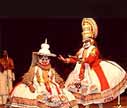
Kathakali is a theatrical dance form of Kerala, which you can see on tours with Kerala Backwater. Known for its elaborate performances, which can last all night, Kathakali was previously staged in only temples and the mansions of the rulers of Kerala. Now Kathakali performances are open to all. Kathakali was previously an all male dance form, with female characters also played by men. Nowadays women too can train in the rigorous process of becoming a Kathakali dancer and perform on stage in Kathakali events. Kathakali events are held through the year and you can enjoy a Kathakali performance on your tour to Kerala with Kerala Backwater
|
|
 Mohiniyattam: Mohiniyattam: |
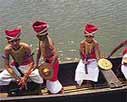
Mohiniyattam is a semi-classical dance form. It contains elements of Bharathanatyam, Kuchipudi and Odissi. It is based on the story of ‘Mohini’, the mythological seductress. The movements are graceful like that of Odissi and the costumes sober and fascinating. It combines songs in Malayalam with Carnatic music. It is performed mainly in Kerala. It is essentially a solo dance. The first reference to Mohiniyattam is found in ‘Vyavaharamala’ composed by Mazhamangalam Narayanan Namboothiri assigned to the 16th century. In the 19th century, Swathi Thirunal, the Maharaja of erstwhile Travancore did much to encourage and stabilize this art form. It was poet Vallathol who again revived it and gave it a standing in modern times through Kerala Kalamandalam which he founded in 1930.
|
|
 Theyyam: Theyyam: |
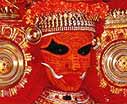
Theyyam incorporates dance, mime and music and enshrines the rudiments of ancient tribal cultures which attached great importance to the worship of heroes and the spirits of ancestors.
|
|
 Tholppavakkoothu: Tholppavakkoothu: |
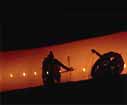
Tholppavakkoothu, literally meaning 'leather puppet play', is a ritual art performed in the Kaali temples of Palakkad district. The story of the play is based on the epic Kamba Ramayana. The play covers the whole gamut of events from Lord Sree Rama's birth to his coronation as the King of Ayodhya. This shadow play is presented in the 'Koothumadam', a specially constructed oblong playhouse on the temple premises.
|
|
 Patayani: Patayani: |
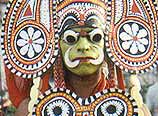
Patayani is a week- long ritual dance, held in Kaali temples on the banks of the Pamba river during the Malayalam months of Meenam and Medam (March - April).
|
|
 Velakali: Velakali: |
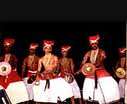
The dancers, clad in the traditional clothes and colourful headgear of the medieval Nair soldiers, engage in vigorous movements and dexterous sword play, to the accompaniment of an orchestra comprising the maddalam, ilathalam, kombu and kuzhal.
|
|
|